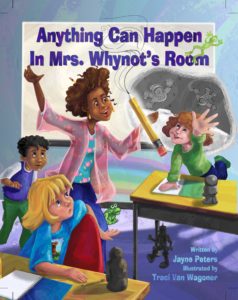Anything Can Happen in Mrs. Whynot’s Room
Author: Jayne Peters
Illustrator: Traci Van Wagoner
Published October29,2014 by Puddle Duck Publishing
Summary: In Mrs. Whynot’s classroom writing is magical; pencils hover and clay characters come to life. But… everyone has something they find difficult and Marcy is no exception. She would like to do ANYTHING but write. She has NOTHING to write about. By talking to her classmates, playing with words and listening to stories Marcy realizes she has lots of tales to tell.
Classroom Ideas Written By the Author:
To the reader, once a book has been published, writing can seem magical and easy. (Disclaimer: There is some magic in Anything Can Happen in Mrs. Whynot’s Room) However, writing is the product of many hours of thinking, talking, questioning, observing, reading, and imagining with a huge amount of perseverance, grit and love. These are some of the skills our students need to further their creative journey and their love of reading and writing.
So let’s start with the first hurdle. Everyone, at one time or another, struggles with capturing ideas to write about. Mrs. Whynot, in Anything Can Happen in Mrs. Whynot’s Room, generates excitement and urges her students to think differently. She encourages discussion and creativity when she hands each student a hunk of clay that can be molded into any character they’d like. She wants them to write about everyday things and to use their imagination. Students learn they have full control over their story and that anything can happen as long as they can convince their reader. Mrs. Whynot gives some good advice when she says, “Write about what you know! Write about what you do! But most importantly, write about what you love!”
Read Aloud: Discussion Questions
Before Reading
Look at the cover
- Who are the author and illustrator?
- What do you notice?
- What do you think the book will be about?
- What characters would you expect to find in the story?
- Do you think Mrs. Whynot’s name was chosen for a reason?
Read the back cover
Synopsis: In Mrs. Whynot’s classroom writing is magical; pencils hover and clay characters come to life. But… everyone has something they find difficult and Marcy is no exception. She would like to do ANYTHING but write. She has NOTHING to write about. By talking to her classmates, playing with words and listening to stories, Marcy realizes she has lots of tales to tell.
- What do you know now?
- What is one thing you find difficult?
During Reading
- Page 4: Look at the door. It says “Imagination Required”. What does that mean?
- Page 4: Why did the author use the word trudged? If she used skipped, walked, ran, plodded, etc… would they mean the same thing? Discuss the importance of using verbs that carry the message you want as an author.
- Page 15: What do you think the grayed illustration represents? (Could she be imagining herself restless and tired as she tries to come up with an idea? Could she be thinking that her ideas are so boring, everyone has fallen asleep?
- Page 29: “She bounced up to the whiteboard and whirled around to face the class.” Discuss how Marcy is feeling now. What words did the author use to help you understand how she feels?
- Page 32: Talk about the gray bubble. (Do you think she is continuing her story that she shared with the class?)
After Reading
- Was the title an appropriate one? Why or why not? What would you call the book if it was your story?
- Can anyone make connections to Marcy? (Text to self, text to text or text to world)
- Make a list like the one below with the students as you discuss all of the things Marcy did to help her become more comfortable and confident writing:
- Molding a clay character
- Talking about and listening to ideas
- Creating an authority list
- Making an “All About Me” collage
- Getting ideas from other stories and changing them to suit your writing
- Becoming a word sleuth
- Carrying a writer’s notebook everywhere so that you can write down ideas
- Have students:
- create an “authority list” in their writer’s notebook listing all of the things they know about or like
- create an “All About Me” collage to jumpstart their ideas
- keep lists of interesting words as they are reading or listening to others. Interesting verbs can be especially useful.
- Talk about their writing ideas and tell lots of oral stories
- Teach students to “Show Don’t Tell” when they write. When we read we often need to infer (read between the lines) so when we write we need to show the reader what is happening instead of telling them.
Example: (Page 12) Marcy gulped, her hands began to sweat, and she stammered, “But I can’t write.” How is Marcy feeling? Nervous? Afraid? Unconfident? That’s way more interesting than if I just said: Marcy was nervous. “But I can’t write,” she said. - Page 24: We hear the beginning of Larissa’s story. Challenge students to finish it. I would love to hear about the mischief Herman gets himself into
- Pages 31-32: Finish Marcy’s story for her. Figure out what the promise was her dad made to the witch and write about it.
- Traci Van Wagoner did an amazing job illustrating Anything Can Happen in Mrs. Whynot’s Room. Learn more about her: https://tracivanwagoner.blogspot.com/ https://www.tracivanwagoner.com/
- Have students mold their own clay characters and use them in their next story.
About the Author: Jayne Peters is an elementary school teacher/ literacy mentor who has taught in Nova Scotia for twenty-five years. As a child she loved sneaking up on tadpoles, late night reading under the covers and spending time at the cottage. Today, she loves watercolor painting, sunny days and country music. She currently lives in a house filled with red heads, loves molasses on “Grampy’s” homemade bread and wants the covers to stay neatly tucked in at night. When she isn’t teaching, reading or writing you will find her practicing yoga and spending quality time with her family. She is the author of Messy Jessy, Messy Jessy Get’s Active and Whispering Wings (available both in French and English). Jayne lives in Lantz, Nova Scotia, with her husband and their three children. Visit her website at http://puddleduckpublishing.com
About the Illustrator: Illustrator Traci Van Wagoner holds degrees in illustration from Utah State University and in toy design from the Fashion Institute of Technology in New York City. A longtime member of SCBWI, Van Wagoner has illustrated many children’s books, and her work appears in magazines, newsletters, and on toys and games. When not painting, she is designing and developing games with her husband at Imagine That! Design, gardening on her roof, or walking her dog in the BIG city. Her motto is live, laugh, and learn.
Thank you, Jayne, for your great classroom ideas with your book!



